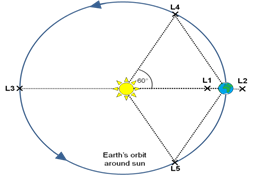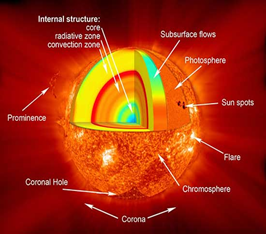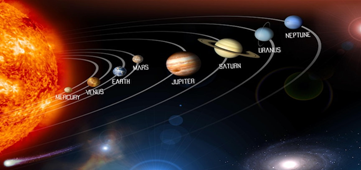

Context
India took its first step towards the completion of its first-ever solar mission. Recently, Aditya L1 launched successfully, that could revolutionise the understanding of the Sun's dynamics and space weather.
- Aditya L1 successfully launched on September 2, 2023 from Sriharikota.
About the Mission:
- The Aditya-L1 mission is the first space-based observatory-class Indian solar mission to study the Sun.
- Objective: The major objectives of Aditya-L1 mission are:
- Study of Solar upper atmospheric (chromosphere and corona) dynamics.
- Study of chromospheric and coronal heating, physics of the partially ionized plasma, initiation of the coronal mass ejections, and flares
- Observe the in-situ particle and plasma environment providing data for the study of particle dynamics from the Sun.
- Physics of solar corona and its heating mechanism.
- Diagnostics of the coronal and coronal loops plasma: Temperature, velocity and density.
- Development, dynamics and origin of CMEs.
- Identify the sequence of processes that occur at multiple layers (chromosphere, base and extended corona) which eventually leads to solar eruptive events.
- Magnetic field topology and magnetic field measurements in the solar corona.
- Drivers for space weather (origin, composition and dynamics of solar wind.
- Launch details:
- Four months from now, the spacecraftwill be successfully placed on its Halo orbit, L1, near the Sun.
- Soon after that, its seven payloads will come into action to find out answers to some of the most intriguing questions about the Sun.
- It will revolve around the Sun with the same relative position and hence can see the Sun continuously.

- Payloads: The spacecraft carries seven payloads to observe the photosphere, chromosphere and the outermost layers of the Sun (the corona) using electromagnetic and particle and magnetic field detectors
- The seven payloads are-
- Visible Emission Line Coronagraph(VELC)
- Solar Ultraviolet Imaging Telescope (SUIT)
- Solar Low Energy X-ray Spectrometer (SoLEXS)
- High Energy L1 Orbiting X-ray Spectrometer(HEL1OS)
- Aditya Solar wind Particle Experiment(ASPEX)
- Plasma Analyser Package For Aditya (PAPA)
- Advanced Tri-axial High Resolution Digital Magnetometers
- Among those seven payloads, four of which will observe the light from the Sun and the remaining three will measure insitu parameters of the plasma and magnetic fields.

Details of payload aims:
- The Visible Emission Line Coronagraph (VELC), the primary payload of Aditya L1 will be sending 1,440 images per day to the ground station for analysis on reaching the intended orbit.
- SoLEXS payload: It is a soft X-ray spectrometer onboard Aditya-L1. The payload is designed to measure the solar soft X-ray flux to study solar fares.
- SUIT payload: The Solar Ultra-violet Imaging Telescope (SUIT) payload images the Solar Photosphere and Chromosphere in near Ultra-violet (UV) and also measures the solar irradiance variations in near UV.
What is L1 point?
- L1 is among the five Lagrange points in the Earth-Sun system.
- At this point, the gravitational forces of the two bodies balance the centrifugal force felt by a smaller object.
- Due to the balance of force, the object is not attracted by the Sun, hence would be able to effectively “hover" in a stable position relative to the two larger bodies.
- Significance:
- This point is located on the line connecting the two bodies. It is situated in the Earth's orbital path around the Sun.
- A satellite placed in the halo orbit around the L1 point has the major advantage of continuously viewing the Sun without any occultation/eclipses.

The Sun and its components:
- The Sun contains about 92% hydrogen and 8% helium.
- Compare that to Earth, where the most common elements are oxygen, magnesium, silicon, and iron.
- The Sun's core is the hottest part, with temperatures reaching up to 15 million degrees Celsius.
- The Sun's visible surface, called the photosphere, is much cooler, with a temperature of about 5,500 degrees Celsius.
- The chromosphere is the second layer of the Sun's atmosphere, and extends from the photosphere about 2,000 kilometers out.
- The chromosphere is also the location of solar activity. For example, solar prominences rise up through the chromosphere from the photosphere.
- The corona is the outermost region of the Sun's atmosphere.

|
Why study of Sun is significant?
|
OTHER ISRO Missions:
|
- To identify magnetic phenomenon: Studying the Sun in detail can shed light on the eruptive thermal and magnetic phenomena which if directed towards the Earth could cause severe disturbances in the near-Earth space environment.
- To study charged particles: The atmosphere of the Earth as well as its magnetic field acts as a protective shield and blocks a number of harmful wavelength radiations including particles and fields.
- Sun’s influence on Earth: Without the solar energy the life on earth, cannot exist. The gravity of the sun holds all the objects of the solar system together.
|
Key facts about Sun:
|
Other Solar Exploration Missions:
- JAXA's other solar exploratory missions are Yohkoh (SOLAR-A) launched in 1991.
- In 2006, Hinode (SOLAR-B) was launched, which was the successor to Yohkoh (SOLAR-A), the orbiting solar observatory.
- SOHO (along with NASA and ESA) in 1995; and Transient Region and Coronal Explorer (TRACE), along with NASA, in 1998.
Why India needs to gain an edge in solar exploration?
- Increasing Global Space economy: A 2015 report from the Space Foundation estimated the global space economy to be worth $323 billion.
- Growing commercialization: ISRO has been actively promoting private participation in the space sector. Collectively domestic private companies in the space sector have raised more than $245.35 million in funding.
- Development of new technologies: ISRO has been working on developing new technologies such as reusable launch vehicles and Inflatable Aerodynamic Decelerator (IAD).
- Agnikul, a domestic startup in the country has successfully completed the test firing of 3D-printed rocket engines.
- Expansion of satellite-based services: ISRO provides satellite-based services in areas such as remote sensing, satellite-based navigation, and satellite-based meteorology, and is looking to expand these services in the future. ISRO has also decided to lend out high-quality satellite-derived data to students, startups, and tech companies at no /minimal costs to stimulate innovation.
|
Indian Space Research Organization (ISRO):
|


